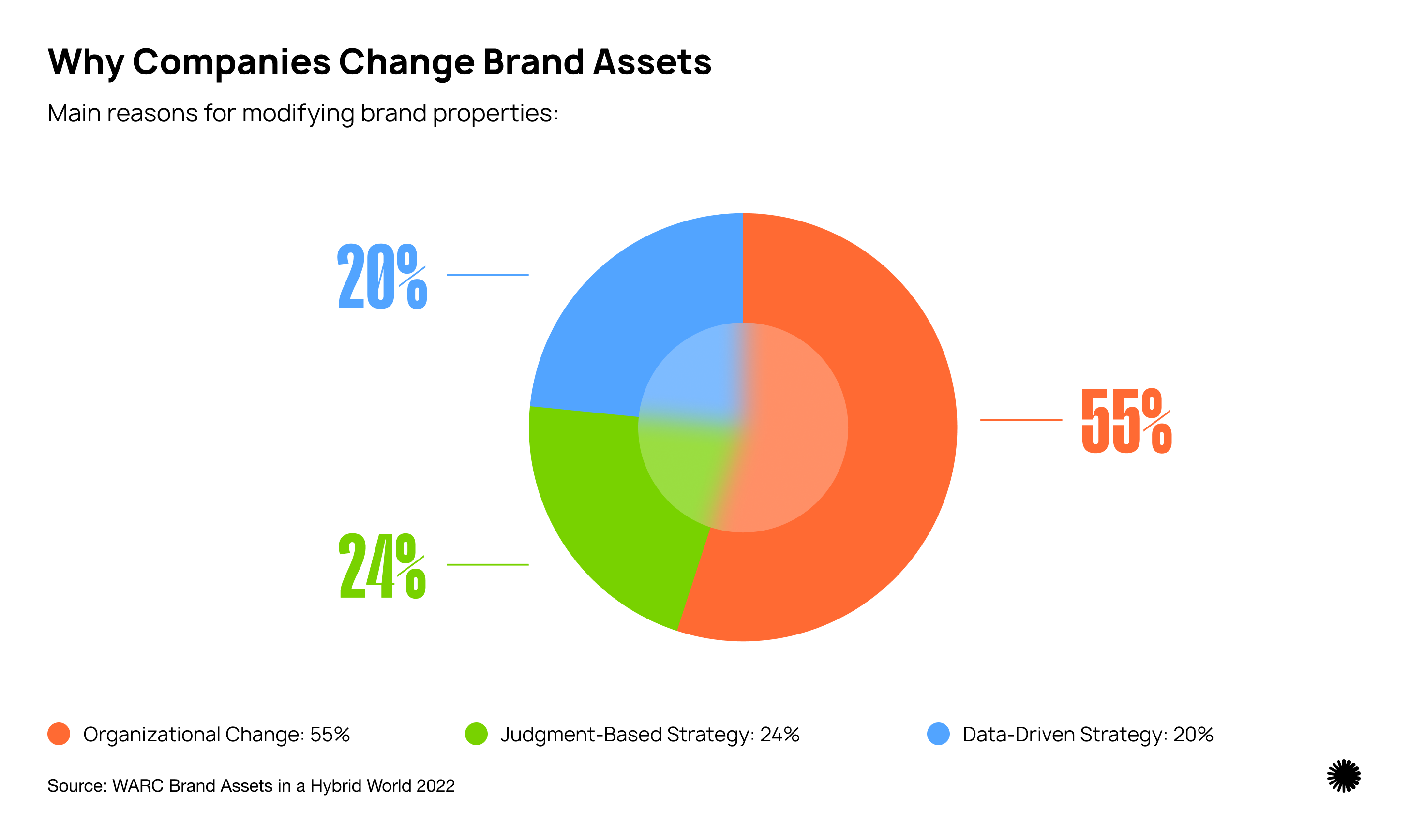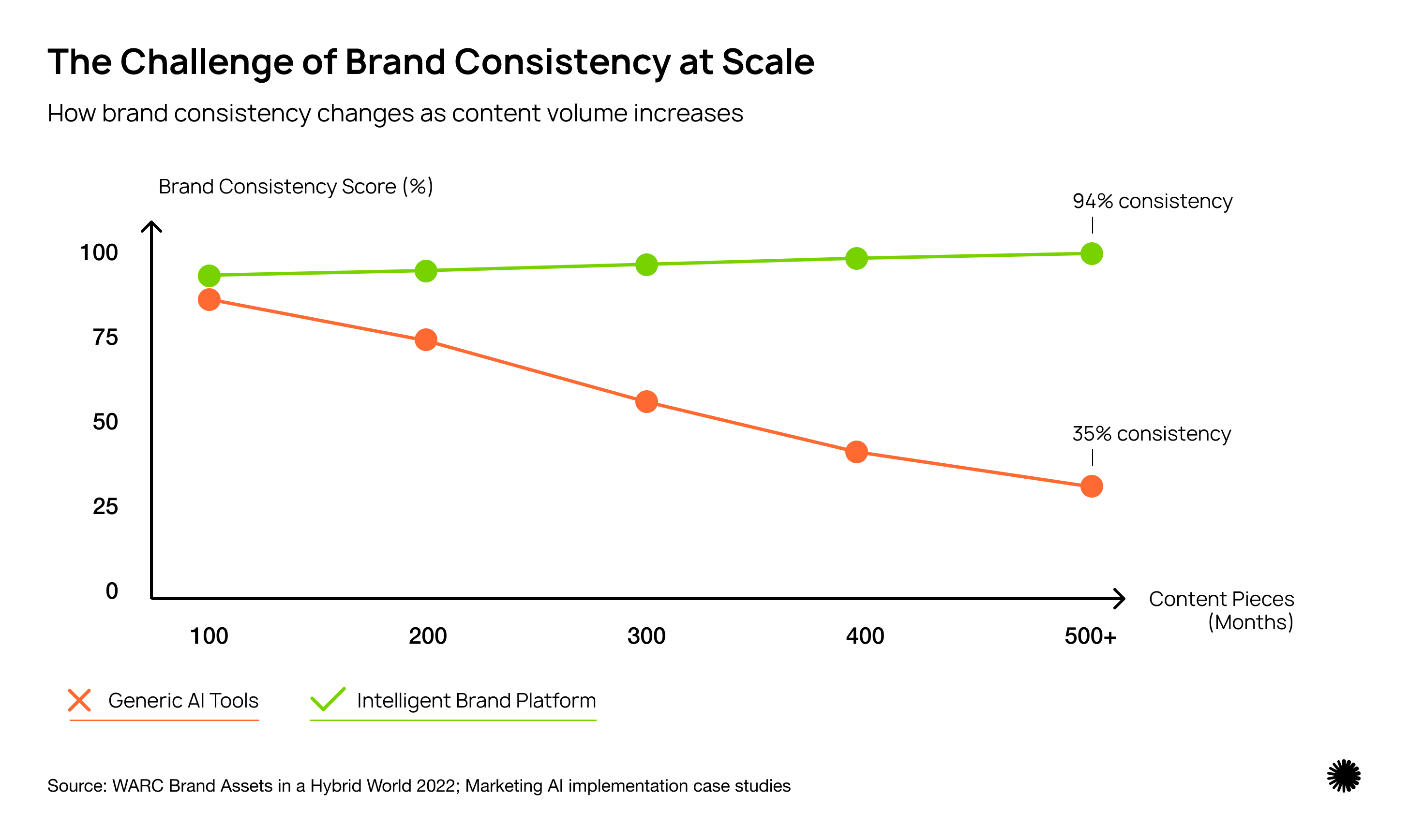Blog

Every CMO faces this challenge now: AI makes it possible to create 10x more content, but creating 10x more content can destroy your brand.
More isn't better if it's inconsistent. Speed isn't valuable if it's generic. Scale is meaningless if nobody recognizes you.
This is exactly what's happening in the market. Companies embrace AI for content creation and immediately start producing more posts, more social media, more emails, more ads, and in the process lose the distinctive brand identity that made them valuable.
The solution isn't to avoid AI. It's to understand what brand consistency really means in an era of AI-powered production.

55% of companies change their brand properties due to organizational changes, not strategy. Only 20% make changes based on data. The rest rely on judgment.
What this tells us: most companies are terrible at valuing and measuring their distinctive brand assets. They change logos, slogans, color palettes, and visual styles without hard data, often simply because a new CMO arrived or the team got bored.
This was expensive and damaging before AI. Now it's catastrophic.
When your brand assets constantly shift, recognition suffers because customers have to work harder to recognize you. Equity evaporates because you never build long-term associations between your brand and specific visual or verbal cues. Creativity deteriorates because teams lack clear guardrails, so every campaign starts from scratch. Efficiency collapses because more time is spent debating "what our brand looks like" instead of creating campaigns.
According to David Taylor, CEO of the brandgym: "Consistency is a critical metric, measuring whether assets are being deployed in the most consistent way possible and with a consistent level of support and investment."
Now multiply this problem by AI-generated content production. If you're creating 10x more content without clear brand consistency, you're not building a brand, you're creating noise.

The answer isn't rigid, unchanging brand guidelines that stifle creativity. That leads to boring, formulaic work that might be "on brand" but makes nobody care.
The answer is fresh consistency, the art of maintaining core brand identity while continuously innovating in execution.
Think of your brand like a jazz musician. Consistency is the melody, rhythm, and key that make the song recognizable. Freshness is the improvisation, interpretation, and innovation that make each performance unique.
Great brands do both. Core elements remain consistent (color palette, typography, tone of voice, visual style, core values) while creative execution stays fresh (campaigns evolve, formats change, storytelling adapts to moments and platforms).
The mistake most brands make is confusing the two. They either keep everything so consistent it becomes boring and invisible, or constantly reinvent themselves and never build lasting brand equity.
To maintain brand identity while scaling AI-generated content, you need clear definition across five pillars: visual identity, voice and tone, brand values and positioning, content formats and structure, and customer experience.
For each pillar, core elements must remain consistent while creative execution can and should vary. For example, in visual identity, your color palette and typography system remain fixed, but campaign-specific visual themes and platform adaptations can evolve.

AI fundamentally changes how brands maintain consistency, for better or worse.
Generic AI tools know nothing about your brand. Every generation requires detailed prompts and even then, results vary widely. Different team members prompt differently, creating inconsistency at scale. Generic tools don't learn from your feedback, so you make the same corrections repeatedly.
When properly implemented, AI is the best brand consistency tool ever created. AI never forgets your brand guidelines, doesn't need to reference a 50-page document because it has your brand DNA embedded in its training. Once configured correctly, AI can generate 1,000 pieces of on-brand content as easily as 10. Consistency doesn't degrade at scale.
AI can analyze which brand applications perform best and optimize future outputs accordingly. It learns what "on brand AND effective" looks like specifically for you.
Generic AI tools make you responsible for consistency. You prompt, review, correct, and hope the next person does the same. It's exhausting and ineffective.
Brand intelligence platforms make the technology responsible for consistency. Your brand DNA is configured once by experts, then the system generates on-brand content automatically.
Brand Intelligence Engine: Unlike generic AI tools that require constant prompting, Pupila is pre-configured with your brand DNA by branding experts. Your photographic style, color palette, and tone of voice are built into the system. Just describe what you want in natural language. The platform learns your brand's unique success patterns, not generic best practices.
Unified Platform: Instead of juggling 5 to 7 different tools (ChatGPT for text, Midjourney for images, Canva for design, Buffer for social media), Pupila provides a single source of truth for all brand assets and guidelines. The workflow is integrated from image creation through copywriting, campaign building, distribution, and analytics. White-glove onboarding where design experts configure your entire brand system.
Human + AI Partnership: We offer personalized onboarding where our design team configures your entire brand system. We continuously refine settings based on performance data. Portuguese-language support with real humans who understand your market and culture.
Performance Learning Loop: Every asset is tracked. We know which visuals drive conversions for your brand. The platform gets smarter about your brand with every use. We offer predictive recommendations like "This visual style converts 3x better for your audience."
We don't just generate content. We amplify your brand's unique voice at scale.
For CMOs ready to scale content without losing brand identity, start by documenting your brand DNA in AI-ready formats. Don't just have brand guidelines, have brand DNA with complete color palette with hex codes, typography system with actual font files, photography style guide with examples of what works, graphics elements library, personality traits with specific examples, and your top-performing content with analysis of why it worked.
Choose technology that learns your brand. Stop using generic tools that treat your brand like everyone else's. Move to platforms that understand YOUR specific brand DNA.
Create a consistency plus creativity culture. Core brand elements are non-negotiable, but creative execution is encouraged. Innovation happens within the brand framework, not outside it.
Establish a performance learning loop. Generate brand-consistent content using AI, distribute across channels and measure performance, analyze which brand applications work best for YOUR audience, optimize brand expression based on data, and codify winning patterns back into your brand system.
With Pupila, every asset is tracked. The platform knows which visuals drive conversions specifically for your brand. It gets smarter about your brand with every campaign.
Fragmented tools create fragmented brands. When you use ChatGPT for copywriting, Midjourney for images, Canva for design, HubSpot for email, Buffer for social media, and Google Analytics for measurement, you create 6 different places where brand consistency can break down.
The Pupila alternative is a unified marketing platform where brand intelligence flows through every function. Create images that are already on-brand, write copy that's already in your voice, build campaigns that are already consistent, distribute content already optimized, analyze performance learning what works for YOUR brand. One source of truth. One consistent system. One continuously improving brand.

Company A uses ChatGPT, Midjourney, and various tools, creates 500 pieces of content per month where each requires 30 minutes of brand alignment review, spends 250 hours monthly checking consistency, still produces off-brand content that confuses customers, and sees brand recognition declining despite content volume increasing.
Company B uses an integrated brand-trained system (Pupila), creates 800 pieces of content per month, automatic brand consistency with only 5 minutes review for quality, saves 67 hours monthly on consistency checking, publishes zero off-brand content, and sees brand recognition increasing alongside content volume.
The difference: Company B creates 60% more content in 73% less time while building stronger brand equity. That's the fresh consistency advantage.
As AI content generation becomes ubiquitous, brand consistency becomes the ultimate differentiator.
Think about it: when everyone can generate professional-looking content at scale, what makes you stand out? Not the quality of individual assets, AI levels the playing field there. Not the volume of content, AI makes infinite scale possible for everyone.
What matters is the consistency and distinctiveness of your brand across all that content. The brands that win will be those who have crystal-clear brand DNA, use AI that amplifies (not dilutes) that DNA, maintain fresh consistency at scale, and continuously learn and optimize what works.
Fresh consistency is the key to building brand value in the age of AI.
55% of companies change brand assets due to organizational changes, not strategy. Fresh consistency means maintaining core brand identity while innovating in creative execution. Generic AI tools require constant brand policing, brand intelligence platforms maintain consistency automatically. Document your brand DNA in AI-ready formats. Unified platforms prevent fragmentation. Build a performance learning loop. In an AI world, brand consistency becomes the ultimate competitive differentiator. Choose platforms built for brands like Pupila, not just content generation.
WARC (2022). Brand Assets in a Hybrid World. Research on brand asset management (55% organizational changes, 24% judgment, 20% data) and David Taylor insights on consistency as a critical metric.
HubSpot (2024). State of Marketing 2025. Marketing effectiveness statistics and AI implementation trends.
Ehrenberg-Bass Institute. Research on brand recognition and consistency, long-term impact of consistent vs inconsistent brand expression.
<
>